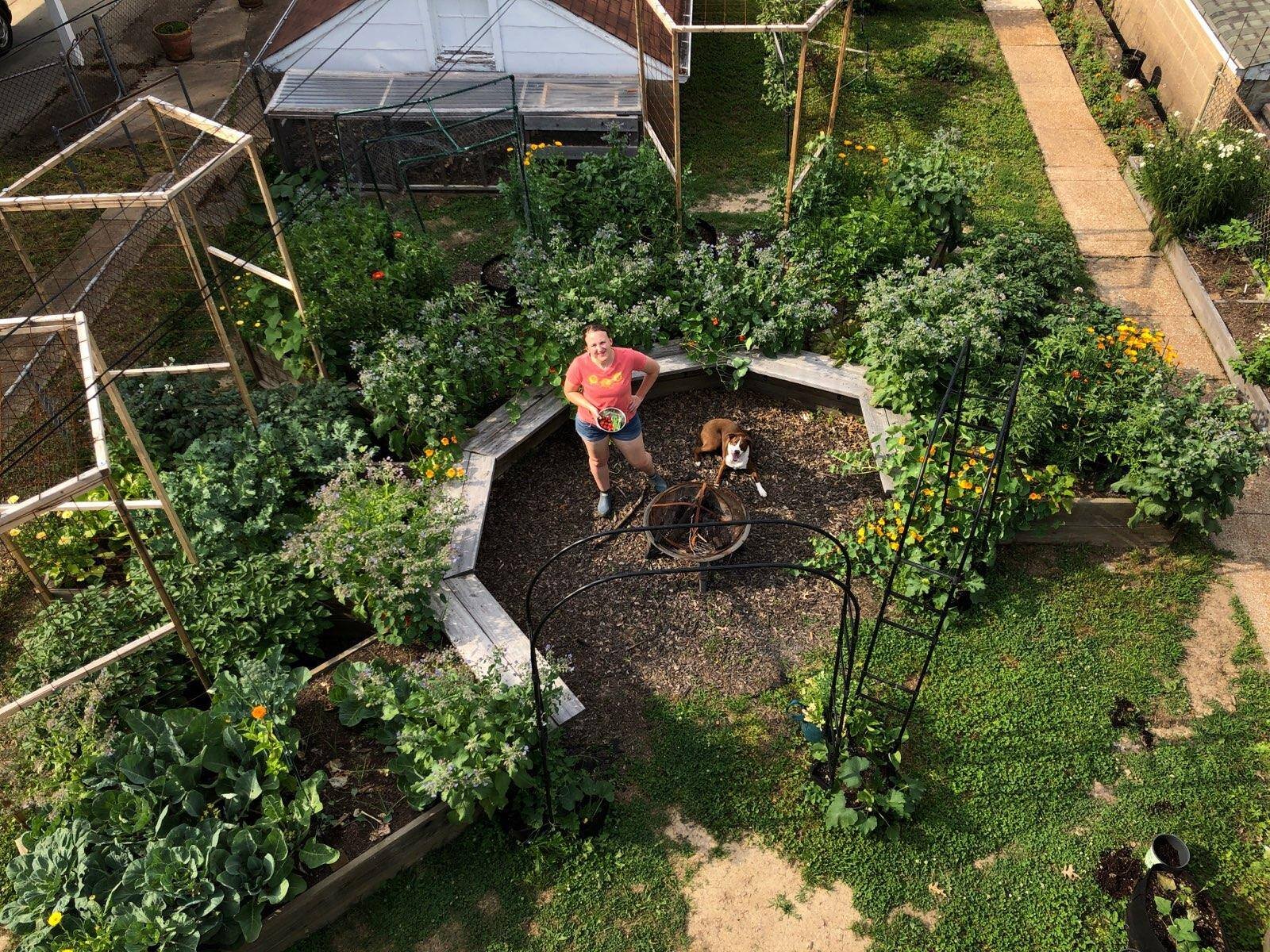How Does Your Garden Grow | Melanie, West County
Former intern, Melanie, is our latest featured FARMily garden!
TELL US ABOUT YOUR GARDEN!
When my husband and I moved in to our house, the backyard was flat lawn. We didn't know anything about gardens. Over the past 4 years, we've developed a few different spaces. We love our 3 large raised gardens for edibles like tomatoes, watermelon, herbs, beans, and anything else we can cram in.
WHAT NEW PROJECTS HAVE YOU BEEN EXPLORING? WHAT’S IN STORE FOR 2021?
Our newest project has been converting a slope full of winter creeper to a native wild garden. This is really going to take off in 2021. Our little girls love to meander through the native garden on the wood cookie steps we've added and catch frogs or even a snake!
WHY DO YOU GARDEN?
Gardening is so fun because its dynamic- you can easily pivot and try something new. Im addicted!
How does YOUR garden grow? Submit your photos and tell us more at urbanharveststl.org/share-your-garden
How Does Your Garden Grow | Ronald, JeffVanderLou
Learn some planting wisdom and check out the beautiful garden of FARMily member Ronald Jones of BlackBerry Landscaping, LLC!
WHY DO YOU GARDEN?
I garden because it's therapeutic and it allows me to escape the real world. I started gardening back in 2008 as a hobby and it soon turned into a passion. The benefits of gardening is it increases my emotional well-being.
DO YOU HAVE ANY TIPS OR TRICKS FOR GARDENING?
The only trick I have is when I'm in the yard gardening I love to listen to James Brown greatest hits and the plants and trees seem respond well.
WHAT IS YOUR FAVORITE THING TO PLANT?
When it comes to plants one of my favorites are the Giant Phlox. (pictured above)
WHAT’S COMING UP FOR YOU THIS SEASON?
My plan Spring 2021 is to build and Herb Garden.
Follow along with Ronald’s gardening adventures on Instagram and Facebook!
How does YOUR garden grow? Submit your photos and tell us more at urbanharveststl.org/share-your-garden
How Does Your Garden Grow | Rachel, Tower Grove South
Learn about Rachel, our first featured FARMily gardener!
How long have you been gardening? How did you get started?
I started experimenting with gardening in the spring of 2014. I loved juicing and it was expensive as a recent graduate, so I took to the internet to do some research to grow veggies. I'll admit, I didn't start easy AT ALL. I started with fruit seeds (lemon, apple, pear, etc.) and I did get germination and growth, but overall realized this would take YEARS to get fruit and I wasn't in a semi-permanent location. From there I stumbled into regrowing veggies from scraps--lettuce was super easy and a super cost savings! But it only works for so long before the plants need soil or something goes funky.
While in graduate school I determined that I wasn't going to let apartment living stop me. I signed up for a couple of community gardens (one at school and one in my neighborhood). This was my first time getting my hands into some soil and my gardening passion took root. The trouble with most community gardens is you don't know what was grown in the plot before you. I learned how much quality soil makes a difference as well as crop rotation and getting a handle on weeds early!
Tell us about your garden (what area of STL you live in, how much space you have, challenges in location, etc...)
One challenge is too much sun/heat for some of our veggies. Cilantro, leafy greens and brassicas are somewhat difficult to grow because they don't get enough shade. This leads me to having to "grow my shade". What I mean by that is growing veggies that love sun and putting other cool weather veggies underneath to protect from the heat when we get odd hot days early or late in the season.
What do you enjoy most? What benefits do you see?
I love starting seeds! That's when most failure happens too. This keeps me humble and continually learning. Just when I think I've learned all the ways to grow tomatoes, someone literally grows them upside down! Experiment and don't think you need to learn everything before you get growing. Another benefit I see is the amazing gardening community, hyper-local and worldwide. Most gardeners want to share and see what others are doing. It's a great way to feel like you are getting a tour of someone's garden without being there.
Do you have any tips or advice to share?
Start small and with food you know you like to eat. It takes a lot of patience for most things to grow. So if by the time it's ready to harvest, if you don't like it, then that's a waste of your time and energy. Also try to start with plants you can get a quick harvest in 30-45 days (radishes, beets, lettuce, kale). For the first couple of years I purchased seedling starts and they are still really cost effective (especially food you continuously harvest such as tomatoes, peppers, beans, cucumbers). Honestly, you can't mess up much in the garden, which is the magic of plants. Sure, you can refine your skills to get plants to be more productive, but most will give you a decent harvest if you just meet their basic requirements of light and water needs.
What's your favorite thing to grow?
Anything edible because I want to enjoy the fruits of my labor--I don't want to unnecessarily sweat for a beautiful yard! Just kidding (kinda)--I have started to enjoy growing flowers more, specifically natives in my front yard. I do enjoy summer veggies a lot. Tomatoes will always have a place in my garden along with beans, garlic and cucumbers. Peas found a new place in my heart last spring and I found myself working and snapping off a few peas to munch on. I try to grow something different every year to keep things interesting.
What most excites you about your garden in 2021?
This year I'm going to work more on preserving the garden. I grew a lot of odd varieties last year, which was fun and plan to have some this year, but overall I want to stick to tried and true varieties to get a bumper harvest. I also love composting because it takes 6 to 9 months for me to get a finished batch and it feels like such an accomplishment! This year already I have two of my three bins full. In past years, I'm lucky if I have 1 bin half way, so I'm excited about all the compost I will produce for my garden on site. Last year I gave away over 250 plants, which was really fun to provide that to those in the community who were staying home and starting gardens.
Follow along with Rachel’s gardening adventures (and free plant starts!) on Instagram (@Greathouse_Garden) or Facebook (@GreathouseGarden) .
How does YOUR garden grow? Submit your photos and tell us more at urbanharveststl.org/share-your-garden
Skullcap and Mullein for Health and Wellness
Learn how skullcap and mullein can be grown and used for therapeutic benefits!
By Libby Landes, Leadership in Urban Agriculture Internship, Fall II 2020
SKULLCAP
Scutellaria lateriflora
Parts used | Aboveground parts.
Nutrients | Calcium, iron, magnesium, manganese, phosphorus, potassium, selenium, zinc, vitamins B1, B2, B3, and C.
Therapeutic uses | Aids sleep, improves circulation, and strengthens the heart muscle. Relieves muscle cramps, pain, spasms, and stress. Good for anxiety, fatigue, cardiovascular disease, headache, hyperactivity, nervous disorders, and rheumatism. Known to be useful in treating barbiturate addiction and drug withdrawal.
Origins | The American Skullcap is a member of the mint family and native to eastern North America. The name Scutellaria refers to the helmetlike or skullcaplike form of each flower. Lateriflora, meaning “flowering on the side,” reveals that the skullcap’s blooms grow along just one side of its stalk.
Growing habits and cultivation | Skullcap is a perennial, 1 to 3 feet tall, that is found in the wetlands, riverbanks, and marshes in much of North America. It likes a relatively rich, moist but acidic soil and is propagated by seeds or cuttings.
Actions | Compounds in skullcap may bind to a GABA receptor in the brain responsible for modulating anxiety. Skullcap also contains the amino acid glutamine, which provides both sedative and anxiety-fighting effects.
How to use | Skullcap may be ingested orally through capsule, alcohol tinctures, or teas. Some herbal experts may recommend tinctures of the fresh plant to capture more of the healing compounds lost in drying the plant. When smoked, skullcap enters the bloodstream more quickly than other forms of consumption for quick anxiety relief.
Precautions | Drowsiness may result from this sedative herb.
MULLEIN
Verbascum thapsus
Part used | Leaves & flowers.
Nutrients | Calcium, iron, magnesium, phosphorus, potassium, selenium, zinc, vitamins B1, B2, B3, and C.
Therapeutic uses | Acts as a laxative, painkiller, and sleep aid. Clears congestion, soothes inflammation. Taken internally, aids in getting rid of warts. Useful for asthma, bronchitis, difficulty breathing, earache, hay fever, and swollen glands. In past years, research has shown that mullein kills disease-causing bacteria.
Origins | The name mullein may come from the Latin word mollis, which means “soft”, a reference to the plant’s velvety texture. European settlers introduced mullein into North America. In the late 1800s, doctors prescribed mullein for the cough and congestion associated with tuberculosis and other respiratory infections such as laryngitis, whooping cough, influenza, and asthma.
Growing habits and cultivation | Mullein is now found throughout the U.S. and Canada, in dry gravelly or sandy soils along roads and dry fields. Easily grown from seed on the edge of a garden among the other weeds, especially in sandy or rocky soil.
Actions | Mullein is known for its tissue-coating properties as well as anti-inflammatory, antiviral, and antibacterial effects.
How to use | Mullein tea has been used for respiratory problems and touted for its ability to soothe irritated membranes, relieve congestion, and break up phlegm. Infusions of the flower may be dabbed on the skin to heal sores, burns, and infections. It may also be made into a tincture or infused in oil. Mullein has been known to be a base herb in smoking preparations as well.
Precautions | Aside from the seeds, mullein is thought to be safe and well-tolerated.
WORKS CITED
Johnson, R., Foster, S. and Weil, A., 2014. National Geographic Guide To Medicinal Herbs. Washington, D.C.: National Geographic.
Brassica Pests: Solutions (Part 2 of 2)
Once you have identified which pest is attacking your brassica crops, then you can work towards managing the problem. In this case, most of the treatments are very similar for all 3 kinds of caterpillars.
By Rebecca Halcomb, Leadership in Urban Agriculture Internship, Fall II 2020
Once you have identified which pest is attacking your brassica crops, then you can work towards managing the problem. In this case, most of the treatments are very similar for all 3 kinds of caterpillars. There are a few specific solutions, but I’ll note those below:
Row Covers: Cover brassica crops with floating row cover or screen cover from when you plant to when you harvest to keep the butterflies and moths off. You should still regularly inspect though. You can also use pantyhose on cabbage heads, and those will grow with the plant and let enough air, sunlight, and moisture in.
Hand-picking: It can be time-consuming and they can be easy to miss, especially the 2 green species. They like to hide on the underside of the leaves, and blend in with the leaf veins. It’s actually much easier to see their dark green frass (poop) than it is to see them. You can drown them in soapy water once you pick them off.
Use Predators: Hang birdhouses in or near the garden or let the chickens into the garden temporarily once the plants are hardy enough, and they will eat the caterpillars for you.
Plant Tolerant Varieties: Some examples of green cabbage varieties that are a more resistant are Green Winter, Savoy, and Savoy Chieftain. You can also try planting red-leafed varieties of cabbage and kohlrabi, which are less desirable because of lack of camouflage for the 2 green caterpillars.
Attract Beneficial Insects: You can either buy them directly, or plant a good selection of flowers and flowering herbs around your brassicas to attract the beneficial insects that will prey on your pests. Some plants to use for this would be parsley, dill, fennel, coriander, and sweet alyssum. (Be careful if cross-striped cabbageworms are your culprit, because they also destroy parsley.) These flowers will attract parasitic wasps, paper wasps, yellow jackets, and shield bugs. Parasitic wasps will lay their white cocoons on the caterpillars’ backs. Leave the cocoons alone to kill off your pest, and then you’ll have a new generation of parasitic wasps for later waves of pests. If you don’t want to rely on your flowers to attract them, you can purchase trichogramma wasps, and release them to destroy the pests’ eggs.
Use Companion Planting: Interplant companion plants among your brassicas that repel the butterflies/moths, like aromatic herbs such as lemon balm, sage, oregano, borage, hyssop, dill, and rosemary, or high blossom flowers like tall marigolds or calendula.
Use Trap Crops: For Loopers, plant celery or amaranth. For Cabbage Worms, plant nasturtiums or mustard. The butterflies/moths will lay their eggs on those crops first, and then once you see the pests, you can dispose of the trap crop to get rid of them.
Frequent Harvesting: For the cut and come again crops, such as Kale and Collard Greens, harvest the leaves more frequently to interrupt the pest life cycle.
Pheromones: Use pheromone traps to monitor and control their populations.
Biological Pesticides: Spray with BT (Bacillus thuringiensis). It’s a natural bacterium that kills caterpillars and worms. BTK sprays in particular do not harm honey bees or birds and are safe to use around pets and children. One source said to spray for Loopers early in the season as a preventative, and then use again for later waves. For cabbage worms, it said to spray every 2 weeks until they get under control. Another source said that one treatment in late summer approximately 2 weeks before harvest can greatly improve your crop quality. You’ll have to reapply after rain though.
Diatomaceous Earth (DE): DE is a very fine powder that when sprinkled can cut up any soft-bodied insect that comes into contact with it. This also has to be reapplied after rain.
Insecticidal Soap: Spray with Organic Insecticidal soap, but this also has to be reapplied after the rain.
Other Repellent Sprays: For Loopers, you can spray the crops with liquefied and strained cabbage loopers or hot pepper spray.
Seasonal Clean Up: For the cabbage worms, do a thorough fall clean-up of old plants and debris, since the butterflies like to overwinter there. (The white cabbage butterfly usually shows up early in the spring because they overwinter instead of migrate.)
Use Decoys: This method is a little experimental, but supposedly the Cabbage Butterflies are territorial and don’t like to lay their eggs if they think another female has already claimed your plants. So you can make white butterfly-shaped decoys out of plastic or another durable material, and put them by your garden plants. Make them 2 inches wide, and with 2 black spots on the upper wing. I think I’m going to repurpose some milk cartons and give it a try. Here’s the link to a template: http://goodseedco.net/blog/posts/cabbage-butterfly-decoy
RESOURCES
This was a very beneficial website that gave some practical tips on controlling cabbage loopers: https://www.planetnatural.com/pest-problem-solver/garden-pests/cabbage-looper-control/
Missouri Botanical Garden has info and tips:
Imported cabbageworm: https://www.missouribotanicalgarden.org/gardens-gardening/your-garden/help-for-the-home-gardener/advice-tips-resources/pests-and-problems/insects/caterpillars/imported-cabbageworm.aspx
Other Sources:
https://savvygardening.com/guide-to-vegetable-garden-pests/
Brassica Pests: Identification (Part 1 of 2)
Learn to identify the pests that damage brassica crops of collard greens, kale, broccoli, and cabbage.
By Rebecca Halcomb, Leadership in Urban Agriculture Internship, Fall II 2020
I had a lot of pest issues this year, but the ones that did the most damage were the pests that took out my brassica crops of collard greens, kale, broccoli, and cabbage.
I had hand-removed a few caterpillars, but less than a week later, this was what I found when I walked out to my garden on August 14th:
These had been the largest most beautiful collard greens I’d ever grown, and were now covered in caterpillars I didn’t recognize:
When I came to intern at Urban Harvest STL, I noticed one of the same pests I had encountered on my brassicas, and learned it was called a cabbage looper. I originally thought it was just the cabbage looper in various phases that I was dealing with in my garden, but when I started researching and looked back at my garden pictures, I noticed that the caterpillars on my collard greens and kale were different from the caterpillars on my broccoli, so I was dealing with multiple pests. I decided to research both pests I had issues with, and then I also ended up finding info on another cabbageworm called the imported cabbageworm. That caterpillar looked very similar to the cabbage looper, but the butterfly was different, so I wanted to address those as well.
First let’s look at how to identify all 3 brassica-eating culprits.
Cabbage Looper ID
Here’s a picture of the cabbage looper moth to look out for.
It will lay eggs that look like this.
As a caterpillar, it will look like this.
Imported Cabbage Worm ID
The imported cabbage white butterfly to watch out for, that produces the green imported cabbage worm, looks very similar to the cabbage looper caterpillar.
Their eggs are also tiny and white, but more cone-shaped.
This is what the green cabbage worm looks like. It’s slightly fatter, doesn’t make the distinctive loop with its back when it crawls, and has a faint yellow stripe down the back.
Cross-Striped Cabbageworm ID
It took me awhile to find the name for the striped caterpillar that skeletonized my collards so badly, but I finally found my worst culprit: the cross-striped cabbageworm.
Here are some pictures of the moth to look out for, the eggs they will lay, and a better close up of the caterpillar:
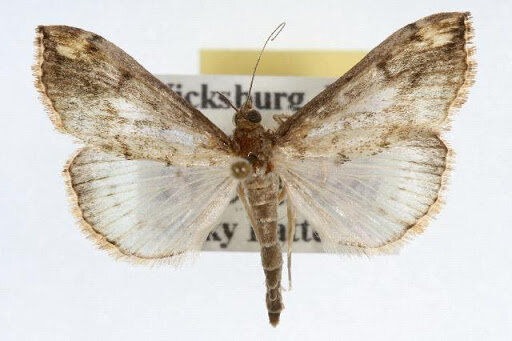
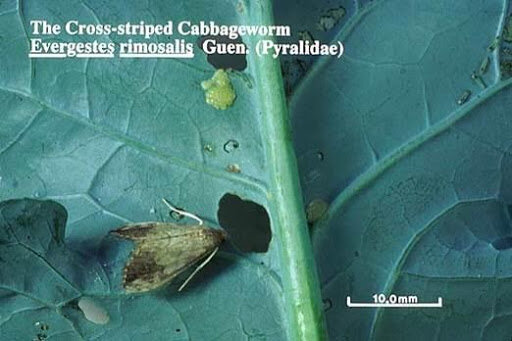
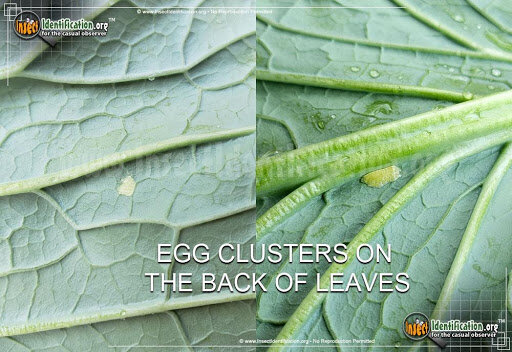
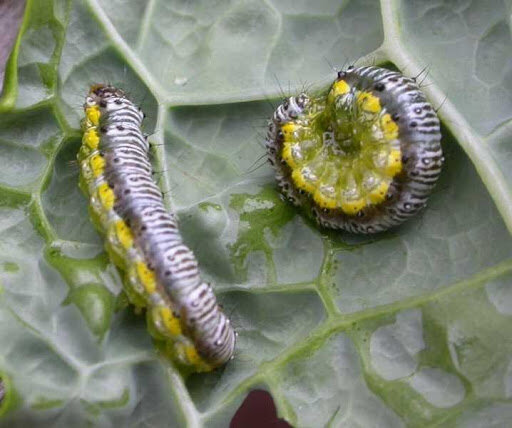
The moral of this is that pest ID can sometimes be tricky, but it’s definitely worth it so you know what you’re dealing with, and the best way to manage the pest so that you can harvest as much high quality crop as possible. In Part 2, we’ll examine how to thwart our brassica foes.
Resources
University Extension websites have compiled a lot of helpful info on garden pests:
University of Minnesota Extension has pictures of the cabbage looper eggs, which are very tiny white round dots, about the size of a pinhead. There are also pictures of the dark green pellets that they excrete: https://www.vegedge.umn.edu/pest-profiles/pests/cabbage-looper
UMass and UConn Extensions have some good info on the Cross-Striped Cabbage Worm: https://ag.umass.edu/vegetable/fact-sheets/cross-striped-cabbage-worm
http://ipm.uconn.edu/documents/raw2/html/579.php?display=print
Non-Extension Resources:
This website has pictures of the various Cabbage Looper stages, their defining characteristics for accurate ID, as well as a full list of the plants they feed on, and their egg laying schedule: http://www.idtools.org/id/citrus/pests/factsheet.php?name=Cabbage+looper
This website notes the difference between the Cabbage looper and Imported cabbageworms: https://www.growveg.com/pests/us-and-canada/cabbage-worm-cabbageworm-cabbage-looper/
Some helpful info that compare the 2 cabbageworms: https://theberkshireedge.com/natures-turn-unwelcome-cabbage-white-butterflies-and-dreaded-cross-striped-cabbage-moths/
Indigenous Agricultural Practices
Learn about Indigenous agricultural practices and some facts about traditional native food.
By Shea Metzler Leadership in Urban Agriculture Internship, Fall I 2020
Click on the image for a PDF version of the guide.
Partner Profile: North Newstead Association
Learn more about Urban Harvest STL’s food donation partner, North Newstead Association.
Back in 2019, the fondly named “Garden Corral” was a weekly favorite among North Newstead Association (NNA) seniors.
After NNA held their elderly services workshops in the shady corner of Fresh Starts Community Garden, workshop attendees would gather around a table stacked with produce freshly picked from Urban Harvest STL farms, including the FOOD ROOF Farm, Kerr FOOD ROOF, and on-location at Fresh Starts. As seniors gathered around the Garden Corral of fresh produce, Farmer Drew from the UHSTL team would stick around to answer questions – “what can you do with a lemon cucumber?” – while they selected their favorite veggies.
Fresh Starts Community Garden, owned by NNA board member and UHSTL partner Rosie Willis, is a community hub where neighbors in the surrounding JeffVanderLou neighborhood come together to garden. Since 2017, UHSTL has been maintaining unclaimed beds in the garden and donating the majority of produce grown there to our community partners. In 2020 alone, UHSTL harvested 1,175 pounds of produce from the garden.
This season, the lively post-workshop vegetable share had to be put on pause. However, with UHSTL farms still producing, NNA’s Community Engagement Specialist Constance Siu has found new ways to distribute produce.
Her first stop is to check in with a couple seniors she has on deck to receive produce weekly. These folks, who are over 65, are already more susceptible to severe symptoms of Covid-19, and one senior who relies on public transportation to reach the grocery store is at even higher risk if and when she leaves her home. Constance divvies up their shares and delivers it to them by the end of the day so that they don’t even need to leave the house.
Often, she gets much more produce than her seniors can handle. When this is the case, she’ll write up a mini “order form” of what’s left over and check in with her neighbors around their office in the O’Fallon neighborhood of North City – the tenants upstairs, the barber shop across the street, the folks at a nearby intersection. They fill out the form and she repackages and delivers their orders.
Sometimes, there just aren’t enough hours in the day to complete this process, so Constance will drop off extra produce at Bread of Life Church in Old North for their Free Food Wednesdays.
“They set up in front of the church with a whole line of food, but they rarely have fresh produce,” Constance explains. “Now, what I hear, is that people come early, and they’ll ask, ‘Where are the cucumbers!?’”
Sharing produce is just one branch of NNA’s many services. The two-woman team works in 21 different neighborhoods (primarily in North City) and collaborates with a wide range of community partners and nonprofits. Their range of services include affordable housing, beautification, neighborhood safety, landlord training and minor home repair.
Navigating the shift to virtual work has been tough, particularly because many of NNA’s services are in-person. Many individuals need to make hard decisions on how to engage – for example, balancing the risk of getting Covid with needing to have repairs done in their homes, especially before winter comes.
When it comes to Constance’s community engagement work, she has also shared the challenges of the technology gap, particularly when working with seniors or individuals without access to wifi. However, she remains optimistic.
“What I’ve learned in the last couple of months is that they are resilient and they’re willing to learn,” Constance says. “And they probably know Zoom better than most of us do by now!”
North Newstead Association brings community partners together to promote economic well being in the North Newstead Association geographic area by providing affordable housing and family support services to the areas low and moderate-income residents. Follow them on Facebook or get in touch at northnewsteadassociationstl@gmail.com.
To volunteer or get involved with Fresh Starts Community Garden, please reach out to Ms. Rosie Willis at 314.685.5183.
Friend or Foe: What You Didn't Know About Weeds
Weeding is one of the most essential tasks in gardening, and the job is never done. These backyard “volunteers” always seem to find a way to thrive. Knowing your weeds can help you out. Some weeds are tricky to combat and can really hurt your plants, but others can be quite useful. Knowing these things can help lessen your load and maybe even bring a little something extra to your garden. This video will focus on a few different weeds and how they might affect your garden.
By Louise Haupert, Leadership in Urban Agriculture Internship, Fall I 2020
For the video transcript, click here.
Environmental Justice Initiatives in St. Louis
Find out more about environmental justice and food justice work happening in St. Louis!
